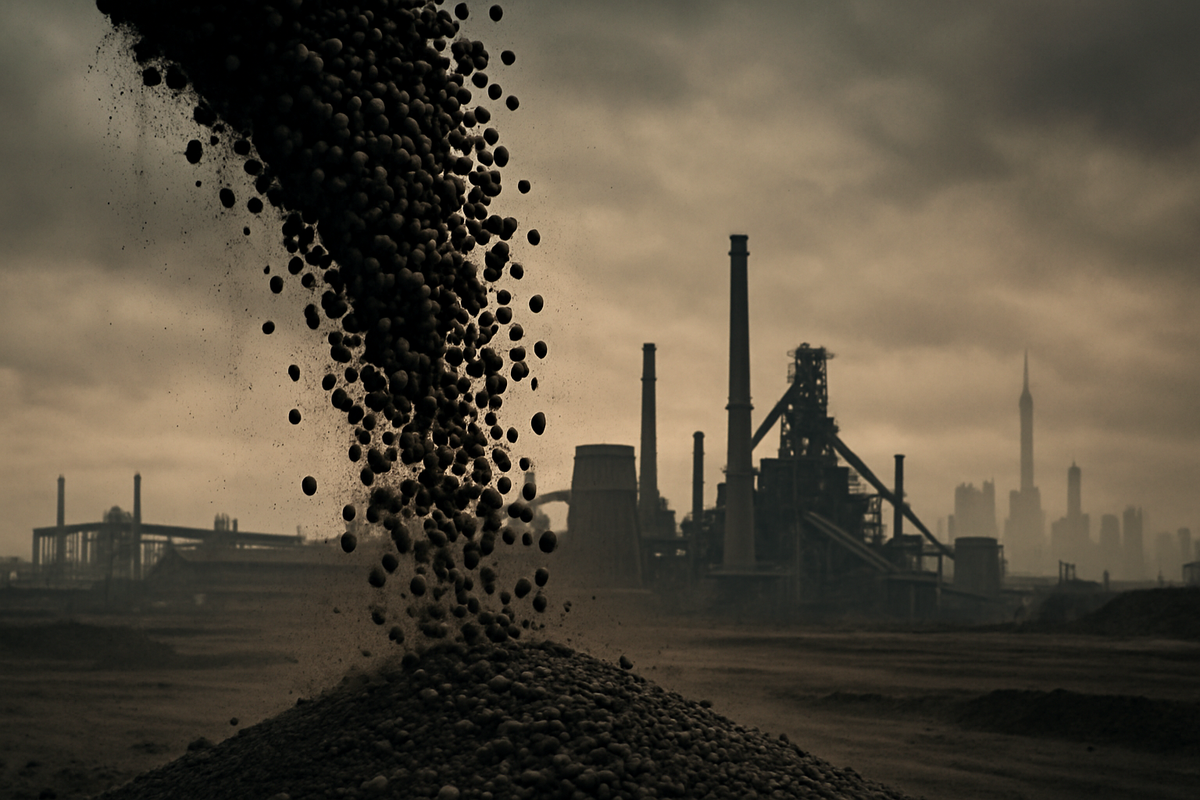
Shanghai, China – October 20, 2025 – Dalian iron ore futures have plunged to a seven-week low, sending ripples of concern across global commodity markets. The sharp decline is primarily attributed to persistent and escalating fears over China's demand for the crucial steelmaking ingredient, signaling a significant downturn in a sector vital to the global economy. This development underscores the profound impact of China's economic health, particularly its struggling property sector and ongoing efforts to curb industrial overcapacity, on international raw material prices.
The immediate implications are stark: major global mining companies face intensified pressure on revenues, while the broader commodity landscape braces for sustained weakness. The tumble reflects a cautious, if not outright bearish, sentiment among traders and analysts, who are closely watching Beijing's policy responses and the trajectory of its economic recovery.
Deep Dive into the Iron Ore Meltdown
The recent fall in Dalian iron ore futures is a culmination of several intertwined factors, all pointing back to a significant contraction in demand from China, the world's largest consumer. On the Dalian Commodity Exchange (DCE), iron ore prices have steadily eroded, culminating in a drop to multi-week lows in October 2025, reaching a seven-week nadir. This decline is not an isolated incident but rather the latest chapter in a protracted period of weakness.
The timeline of events leading to this moment stretches back to early 2024. Iron ore futures began to slip as early as March 2024 due to increased equipment maintenance by steelmakers and environmental curbs in regions like Tangshan, pushing prices to a five-month low. Throughout June, July, August, and September 2025, the trend continued downwards. Key indicators included a two-year slump in new home prices, a dip in China's crude steel output to a seven-month low in July and a 21-month low in September, and rising iron ore stockpiles at Chinese ports, which reached 133.4 million tons in June. The underlying causes are manifold: a protracted property market slump with new home prices falling for an extended period, significant steel production cuts aimed at eliminating outdated capacity (with proposed reductions of 50-200 million tons over five years), overall weak economic growth in China (Q3 2025 growth expected to be the lowest in a year), disappointing credit data indicating dampened demand, and seasonal factors like colder temperatures restricting construction in Q4. Furthermore, renewed US-China trade tensions, including tit-for-tat port fees, have negatively impacted market sentiment.
Key players in this unfolding drama include the Dalian Commodity Exchange (DCE) and the Singapore Exchange (SGX), which serve as central hubs for iron ore price discovery. China's Government and policymakers are paramount, as their decisions on property, steel production, and economic stimulus directly dictate demand. Steel mills and producers adjust their purchases based on market conditions, while global mining companies from Australia and Brazil bear the brunt of declining prices. Market analysts from firms like Mysteel, ANZ, Goldman Sachs, and Moody's provide critical insights that influence trading behavior. Initial market reactions to the recent tumble have been characterized by significant price declines, a "cautious wait-and-see attitude" from steel mills, and a "strong willingness to sell" among traders. A stronger U.S. dollar has also compounded the downward pressure by making dollar-denominated commodities more expensive.
Companies on the Brink: Winners and Losers
The dramatic fall in iron ore prices presents a clear delineation between potential losers and, in some nuanced scenarios, potential winners within the global market. The most significant losers are undoubtedly the major global iron ore mining companies. Rio Tinto (ASX: RIO, LSE: RIO), as the world's largest iron ore supplier, is particularly exposed. The company has already indicated challenges in meeting its iron ore shipment targets, suggesting direct pressure from the weakening market conditions. Similarly, other prominent Australian and Brazilian mining companies, which form the backbone of global iron ore supply, face considerable headwinds. Their revenues and profit margins are directly tied to the price of iron ore, and a sustained period of low prices will inevitably impact their financial performance, potentially leading to reduced investment in new projects and increased scrutiny of operational costs.
On the other hand, the direct beneficiaries are less clear-cut, as the overall slowdown in China's economy also impacts steel demand. However, in theory, steel mills and manufacturers outside of China that rely on imported iron ore could see some relief from lower raw material costs. This could potentially improve their profit margins, assuming their end-product demand remains stable. Yet, the research also highlights that Japanese steelmakers, for instance, are currently struggling due to increased, lower-priced imports of stainless steel sheets from China and Taiwan, which limits their ability to capitalize on potentially cheaper raw materials. The broader impact of China's slowdown means that even if raw material costs decrease, a corresponding drop in global steel demand could negate any potential advantages for these companies. The primary takeaway is a challenging environment for iron ore producers, with limited upside for other players in the immediate term.
Wider Significance and Historical Context
The tumble in Dalian iron ore futures is far more than an isolated market event; it represents a significant barometer of global economic health and China's pivotal role within it. This event fits squarely into broader industry trends of shifting global supply chains, increasing scrutiny on environmental regulations impacting heavy industry, and the ongoing recalibration of China's economic model away from an investment-heavy, property-driven growth. The "ripple effects in the commodity pond" are extensive, impacting not just iron ore but also other raw materials like coking coal, coke, and various base metals, as a slowdown in the world's largest industrial powerhouse inevitably dampens demand across the board.
The regulatory and policy implications are profound. China's government is actively pursuing reforms to address industrial overcapacity, particularly in the steel sector, and is grappling with a prolonged property market crisis. Policymakers' efforts to stabilize the property sector and stimulate broader economic growth are critical determinants of future iron ore demand. Any significant policy shift, whether through increased infrastructure spending or more aggressive property market interventions, could alter the trajectory of iron ore prices. Conversely, continued inaction or ineffective measures could prolong the slump. Historically, the Dalian iron ore futures market has been characterized by considerable volatility, with prices fluctuating widely since 2010, experiencing yearly increases exceeding 70% and drawdowns nearing 40%. While price swings are not unprecedented, the current situation is distinct due to the prolonged and systemic nature of China's property slump and its deep structural impact on steel demand, setting it apart from previous cyclical downturns.
What Comes Next: Navigating the Uncertainty
Looking ahead, the short-term outlook for Dalian iron ore futures remains challenging, with long-term possibilities heavily contingent on China's economic recovery and policy effectiveness. In the short term, analysts from Moody's and BMI Country Risk and Industry Research largely anticipate iron ore prices to remain within the $80-100/ton range over the next 12-18 months, primarily due to persistent weak demand from China and a high global supply. This bearish sentiment suggests that miners and commodity traders should prepare for continued price pressure. Potential strategic pivots for mining companies might include further cost-cutting measures, optimizing existing operations, and potentially delaying or scaling back expansion projects to conserve capital.
Market opportunities, while scarce, might emerge if China's government implements more robust stimulus measures that genuinely revive the property and infrastructure sectors. However, given the current policy trajectory focused on deleveraging and sustainable growth, a return to the boom-time demand levels appears unlikely in the near future. Challenges will continue to include navigating volatile market sentiment, managing supply chain disruptions, and adapting to China's evolving industrial policies. Potential scenarios range from a gradual stabilization if China's economic reforms gain traction, to a more prolonged downturn if the property crisis deepens and global economic growth falters. The key will be the pace and efficacy of China's policy interventions and the global response to a potentially more subdued growth trajectory from the world's second-largest economy.
Comprehensive Wrap-Up and Investor Outlook
The recent tumble in Dalian iron ore futures serves as a potent reminder of the interconnectedness of global financial markets and the outsized influence of China's economic health. The key takeaway is that persistent fears over China's demand, driven by a deeply entrenched property market slump, aggressive steel production cuts, and broader economic deceleration, are the primary forces exerting downward pressure on iron ore prices. This situation is not merely a cyclical dip but reflects structural shifts in China's economy.
Moving forward, the market is likely to remain under pressure, with major iron ore producers facing a prolonged period of lower prices and reduced profitability. The ripple effects will continue to be felt across the global commodity complex, creating uncertainty for commodity-exporting nations and potentially reshaping investment strategies. Investors should closely watch several critical indicators in the coming months: the performance of China's property market (new home sales, property investment), the effectiveness of government stimulus measures, crude steel output figures, and any developments in US-China trade relations. A sustained recovery in these areas would be necessary to signal a turnaround for iron ore, but for now, caution and adaptability remain paramount for market participants.
This content is intended for informational purposes only and is not financial advice





